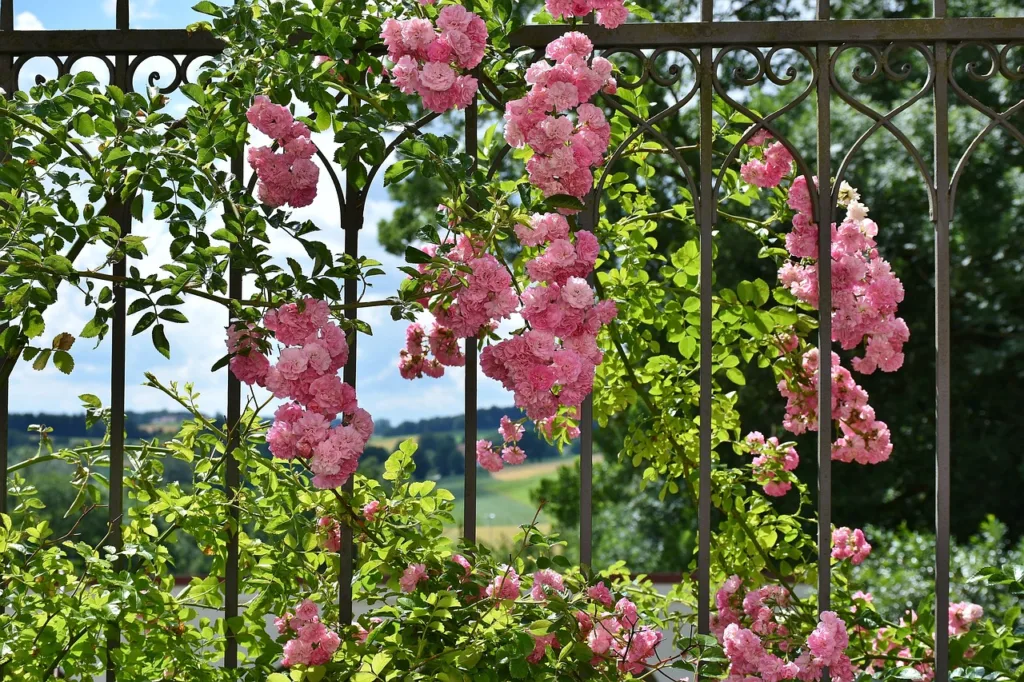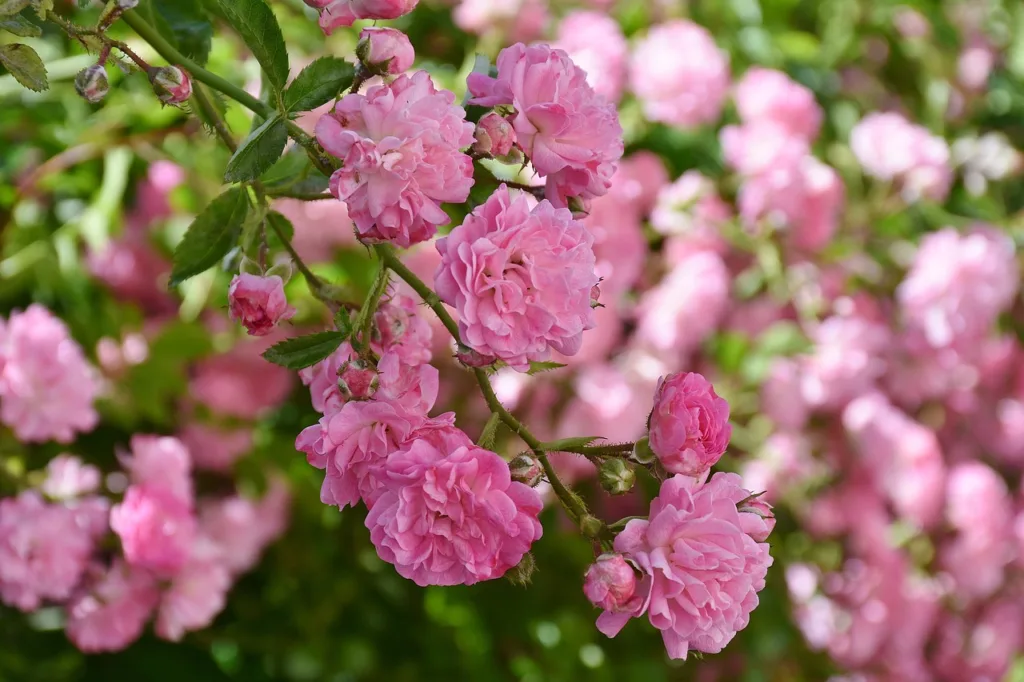Floribunda roses are a popular category of modern garden roses known for their prolific and continuous blooming.
The term “floribunda” translates to “abundance of flowers,” and these roses live up to their name by producing clusters of blossoms throughout the growing season.
Floribunda roses are a beautiful and versatile addition to any garden. Known for their large clusters of blooms and continuous flowering throughout the growing season, these roses are a favorite among gardeners.
If you’re looking to add some color and fragrance to your outdoor space, learning how to grow and care for Floribunda roses is key.
In this guide, we will delve into the essential steps and tips to help you cultivate healthy and vibrant Floribunda roses in your garden.
| Aspect | Description |
|---|---|
| Scientific Name | Rosa (Genus) |
| Common Name | Floribunda Roses |
| Category | Modern Garden Roses |
| Family | Rosaceae |
| Growth Habit | Bushy and Compact |
| Height | Typically 2 to 4 feet |
| Spread | Similar to Height |
| Blooms | Clusters of Medium-sized Flowers; Prolific and Continuous Blooming Throughout the Growing Season |
| Foliage | Dense Foliage; May Exhibit Glossy or Matte Leaves |
| Hardiness | Often More Disease-Resistant and Hardy |
| Versatility | Suitable for Borders, Mass Plantings, and Containers |
| Color Range | Wide Range of Colors, Including Red, Pink, Yellow, Orange, and White |
| Fragrance | Some Varieties Exhibit a Pleasant Scent |
| Adaptability | Well-suited for Formal and Informal Garden Settings |

Choosing the Right Location of Floribunda Roses
Floribunda roses thrive in full sunlight, so it’s crucial to select a planting spot that receives at least six hours of direct sunlight each day.
Make sure the location has well-draining soil to prevent waterlogging, which can lead to root rot. Additionally, ensure there is good air circulation around the plants to minimize the risk of fungal diseases.
Testing Soil Conditions
Before planting your Floribunda roses, test the soil pH to determine if any amendments are needed. Floribundas prefer slightly acidic soil with a pH range between 6.0 and 6.5. You can adjust the soil pH by adding organic matter such as compost or peat moss.
Planting Floribunda Roses
When planting Floribunda roses, follow these steps for optimal growth:
- Dig a hole that is twice as wide and deep as the rose root system.
- Mix in some organic matter like compost or aged manure to enrich the soil.
- Place the rose plant in the hole, ensuring the bud union is just above the soil level.
- Fill the hole with soil and tamp it down gently to eliminate air pockets.
- Water the plant thoroughly after planting to help establish the roots.
Mulching and Watering
Mulching is essential for retaining moisture, regulating soil temperature, and suppressing weed growth around Floribunda roses.
Apply a layer of organic mulch, such as wood chips or bark, around the base of the plants while avoiding direct contact with the stems.
Water the roses deeply once a week, especially during dry periods, to keep the soil consistently moist but not waterlogged.
Pruning and Deadheading
Regular pruning and deadheading are essential tasks to promote continuous blooming and maintain the overall health of Floribunda roses. Here are some tips for pruning and deadheading your roses:
- Prune in late winter or early spring before new growth begins.
- Remove any dead, diseased, or crossing branches to improve air circulation.
- Deadhead spent blooms to encourage new flower production.
- Cut back about one-third of the plant’s growth to shape and rejuvenate the plant.
Fertilizing and Feeding
To ensure healthy growth and abundant blooms, fertilize Floribunda roses regularly during the growing season.
Use a balanced fertilizer specifically formulated for roses, following the manufacturer’s instructions. Apply the fertilizer in early spring when new growth emerges and again in early summer to support continuous flowering.
Pest and Disease Management
Keeping an eye out for common pests and diseases is crucial to maintaining the health and vitality of your Floribunda roses.
Some common issues to watch for include aphids, spider mites, powdery mildew, and black spots. Here are some preventive measures and treatments for pest and disease management:
- Inspect the plants regularly for signs of pests or diseases.
- Remove affected leaves or stems promptly to prevent the spread of infections.
- Use insecticidal soap or neem oil for controlling aphids and spider mites.
- Apply fungicides as needed to combat powdery mildew and black spots.

Overwintering Floribunda Roses
Proper winter care is essential to protect Floribunda roses from harsh weather conditions and ensure their survival through the colder months. Here are some tips for overwintering your roses:
- Stop fertilizing the plants in late summer to allow them to harden off before winter.
- Apply a thick layer of mulch around the base of the plants to insulate the roots.
- Consider using protective coverings or rose cones for added insulation in regions with severe winters.
- Prune the roses lightly in late fall to remove dead or damaged wood and shape the plants.
Types of Floribunda Roses
- ‘Iceberg’:
- One of the most well-known Floribunda Roses.
- Clusters of pure white, double blooms.
- Continuous blooming throughout the season.
- Disease-resistant and hardy.
- ‘Queen Elizabeth’:
- Tall Floribunda with pink, high-centered blooms.
- Named in honor of Queen Elizabeth II.
- Repeat bloomer and vigorous grower.
- ‘Europeana’:
- Compact plant with bright red, double blooms.
- Blooms in clusters and has a mild fragrance.
- Disease-resistant and suitable for borders.
- ‘Sunsprite’:
- Compact and bushy growth habit.
- Bright yellow, semi-double blooms.
- Continuous blooming with a mild fragrance.
- ‘Angel Face’:
- Lavender-colored blooms with a strong, sweet fragrance.
- Compact and rounded growth habit.
- Repeat bloomer and disease-resistant.
Conclusion
Growing and caring for Floribunda roses can be a rewarding experience, bringing beauty and elegance to your garden.
By following the tips and guidelines outlined in this comprehensive guide, you can cultivate healthy, vibrant roses that bloom profusely throughout the growing season.
Remember to provide adequate sunlight, well-draining soil, regular watering, proper pruning, and pest management to ensure the success of your Floribunda roses.
With a little care and attention, you can enjoy the beauty and fragrance of these delightful roses in your outdoor space for years to come.
FAQs
What is meant by a floribunda rose?
A floribunda rose refers to a category of modern garden roses known for their prolific and continuous blooming.
These roses are characterized by clusters of medium-sized flowers, often growing in profusion throughout the growing season. The term “floribunda” translates to “abundance of flowers.”
How big do floribunda roses grow?
The size of floribunda roses can vary based on the specific cultivar. Generally, they have a bushy and compact growth habit, making them suitable for various garden settings.
Their height typically ranges from 2 to 4 feet, and their spread can be similar, creating a well-rounded and manageable plant.
What are the benefits of floribunda roses?
Some benefits of floribunda roses include:
- Abundant Blooms: Continuous and prolific flowering throughout the growing season.
- Versatility: Suitable for various garden designs, including borders, mass plantings, and containers.
- Hardiness: Often more disease-resistant and hardy compared to some other rose varieties.
- Color Variety: A wide range of colors, adds vibrancy to garden landscapes.
- Adaptability: Well-suited for both formal and informal garden settings.
What is the price of floribunda rose in India?
The price of floribunda roses in India can vary based on factors such as the specific variety, size of the plant, and the nursery or supplier.
Prices may range from a few hundred to a couple of thousand rupees per plant. It is recommended to check with local nurseries or online suppliers for current pricing.

